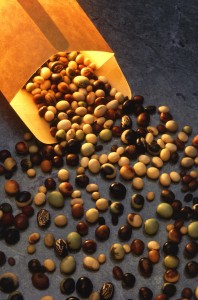20
Oct
EPA Finds Neonicotinoid Seed Treatments To Be of Little or No Benefit
(Beyond Pesticides, October 20, 2014) The U.S. Environmental Protection Agency released a report Thursday that soybean seed treatments with neonicotinoid insecticides provide little or no overall benefits in controlling insects or improving yield or quality in soybean production. While pesticide manufacturer Syngenta has petitioned EPA to raise the allowable levels of another systemic pesticide thiamethoxam on a number of crops, EPA’s report confirms scientific findings that these chemical treatments are unnecessary and inefficacious. Widely used neonicotinoids, which as systemic chemicals move through a plant’s vascular system and express poison through pollen, nectar, and guttation droplets, have been identified in multiple peer-reviewed studies and by beekeepers as the major contributing factor in bee decline.
The report concludes that not only is there no increase in soybean yield when compared to using no pest control at all, but also the potential benefit of neonicotinoid seed treatment is not likely to be large or widespread  throughout the U. S. EPA also found that seed treatments fail to provide protection from target pests during critical times of plant activity, ultimately leading to the assessment that “much of the existing usage on soybeans is prophylactic in nature.”
throughout the U. S. EPA also found that seed treatments fail to provide protection from target pests during critical times of plant activity, ultimately leading to the assessment that “much of the existing usage on soybeans is prophylactic in nature.”
“This report demonstrates, yet again, the need for EPA to ask the very important question of whether a chemical is truly necessary and efficacious before introducing it into the environment,” says Jay Feldman, executive director of Beyond Pesticides. “And because treated seeds are mostly exempt from federal pesticide laws under the treated article provision, this oversight has allowed a dangerous chemical to be used largely unregulated, wreaking havoc on the nation’s pollinators.”
Honey bees and other pollinators have been experiencing a rapid and ongoing population decline in the U.S and other parts of the world since 2006. This has a profound impact on the stability of ecosystems, the economy, and the U.S. food supply. A May 2013 report by USDA found that one in three bites of food depends on pollination, mainly by managed honey bees, and that pollination is valued at $20 to $30 billion annually.
Neonicotinoids are chemically similar to nicotine and are pesticides that are toxic to a broad range of insect pests. They are also known as systemic pesticides, which are pesticides that spread throughout the entire plant structure, making everything from roots to pollen toxic to organisms that come in contact with it. As a result of neonicotinoids systemic nature, pre-treatment practices, and other factors these dangerous pesticides have been linked to the global disappearance of honey bees and other non-target organisms, such as earthworms, birds, and aquatic invertebrates.
Neonicotinoids, like imidacloprid, clothianidin, and thiamethoxam, have already been given two-year moratorium in the European Union (EU). Despite calls for similar action from beekeepers and environmentalists, Canadian officials, and their counterparts in the U.S., have refused to follow suit. Although there has been some success in the form of local ordinances, the U.S. and Ontario, Canada, as well as policy shifts within some U.S. federal agencies, a Canadian beekeeper lawsuit demonstrates the desperation of beekeepers everywhere seeking relief on a broader scale.
In the U.S. courts, Beyond Pesticides, Center for Food Safety, Pesticide Action Network North America, and U.S. beekeepers filed a lawsuit against the U.S. Environmental Protection Agency (EPA) in 2013 calling for a ban on clothianidin and thiamethoxam, which are used extensively on corn, soybean, and canola seeds.
Join Beyond Pesticides in supporting beekeepers across North America in their fight against neonicotinoids and learn the many ways you can BEE Protective by visiting our website! You can also learn more about the growing body of science linking bee deaths to neonicotinoids by visiting Beyond Pesticides’ What the Science Shows.
Source: EPA Press Release
All unattributed positions and opinions in this piece are those of Beyond Pesticides.










